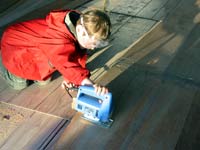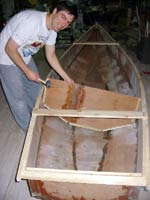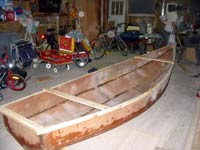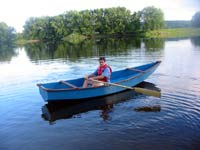Roar2
by Andrew
Jefferies
A year ago my mother was telling me of a friend
of hers who built a 40' schooner using traditional methods and
designs. I was fascinated. My wife shuddered when she saw the
glint in my eye after hearing the story. She knew exactly what
I was thinking. The thought of building a boat
overtook all others.
Fortunately for everyone I soon came to the realization
that I have neither the funds, space nor skills for building
a 40' schooner. I realized I needed a small starter project.
Thus was born my obsession of building a row boat.
 click images to enlarge
click images to enlarge |
I had assumed initially that I would end up building
a dory since they are the common rowboat in this area. (I live
in Fredericton, New Brunswick, Canada. On the St. John River.)
Also, having never built anything that floated I had no preconceived
idea of what building technique I would use. After considerable
“work” researching various styles and building techniques
I decided instead upon Jim Michalak's ROAR2.
There were two things that I really liked about
the design. First, it looks amazing. It is really a sweet looking
boat. It was quite light and the several accounts that I read
described the boat as exceedingly fast. I also liked the sound
of the Stitch & Glue, Instant Boat style construction. It
sounded like something that I could handle.
Having never done anything like this before there
were many details to be worked out. While I waited for the plans
to arrive from Duckworks I undertook research into some stitch
and glue building basics. There is a lot of information on the
web about this technique but I found that there also seems to
be a lot of gray areas in building methods and materials. Every
article I read seemed to contradict the one before.
 In
the end, for epoxy, I decided to heed the advice of several
articles and avoid the cheap brands of epoxy and instead bought
West Systems resin and hardener. This ended up being half of
the entire cost of the boat. After reading a well written article
about epoxy fillers I decided to use standard garden lime as
a filler. This seemed kind of strange at first but seems to
work really well while costing minimal. Since marine plywood
was 3 times the price I decided to go with an exterior grade
Meranti plywood for the hull. For the gunnels, cross braces
and bow and stern pads it was Oak.
In
the end, for epoxy, I decided to heed the advice of several
articles and avoid the cheap brands of epoxy and instead bought
West Systems resin and hardener. This ended up being half of
the entire cost of the boat. After reading a well written article
about epoxy fillers I decided to use standard garden lime as
a filler. This seemed kind of strange at first but seems to
work really well while costing minimal. Since marine plywood
was 3 times the price I decided to go with an exterior grade
Meranti plywood for the hull. For the gunnels, cross braces
and bow and stern pads it was Oak.
The plans that arrived were very good quality
and included two good documents on the construction of the boat.
There were a couple of areas that were vague including the stem
construction and the skeg construction but a little bit of figuring
later easily solved both of those.
Accounts that I had read on the building times
of ROAR2 ranged from 30 to 40 hours. I estimate that my build
time was closer to 50 hours. Now that I have a bit of a clue
what I'm doing with some of the building techniques I think
I could easily cut that down closer to the 30 hour mark.
Drafting out the pieces, cutting and initial assembly
(stitching) of the pieces was straight forward and didn't take
too much time. When the pieces were initially placed, there
were a couple of spots where the plywood pieces didn't fit together
properly Following the instructions I ran a saw down the joints
to clear that up. Be warned though that although I was careful
in my cuts they did add some small differences in the symmetry
between the two sides that is still noticeable.
 The
part of the construction that took the most time and patience
was the actual epoxying. Applying the epoxy is much like crack
filling drywall. I'm not very good at that either! To get a
pretty good finish took many thin coats of epoxy with sanding
in between.
The
part of the construction that took the most time and patience
was the actual epoxying. Applying the epoxy is much like crack
filling drywall. I'm not very good at that either! To get a
pretty good finish took many thin coats of epoxy with sanding
in between.
Two tools that I found invaluable during the
fairing process were a good belt sander (which I got because
of the large amount of sanding I seemed to be doing) and the
detail sander that let me get into the little corners.
An area of the boat that has proved troublesome
are the gunnels. The instructions call for constructing them
out of two laminated ¾ inch pieces stuck together with
glue and screws. While this seemed to work during construction,
after two outings the pieces delaminated around the oar locks.
My theory is that they would have held better had I laminated
using epoxy instead of the exterior wood glue but I'm not sure.
My solution to this has been to put some lag bolts on either
side of all four oar locks as well as regluing with epoxy where
the delamination has occurred. We'll wait and see if this fixes
the problem permanently.
 While
I had planned on using plain old exterior paint for finishing
I found a great deal on marine paint that ended up being much
cheaper. Three coats of primer and paint did wonders to cover
up some of the imperfections in the hull.
While
I had planned on using plain old exterior paint for finishing
I found a great deal on marine paint that ended up being much
cheaper. Three coats of primer and paint did wonders to cover
up some of the imperfections in the hull.
She has been christened “Rowan”.
That's one of the names that my wife had wanted for our daughter
but I didn't like. It does seem to work for a row boat though.
She rows beautifully. I am very impressed at
how fast this boat goes and with such little effort. I would
certainly recommend ROAR2 for any builder whether beginner or
pro.

